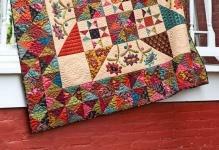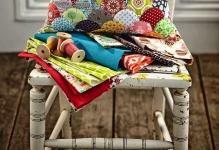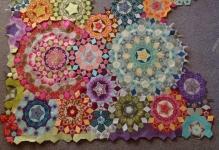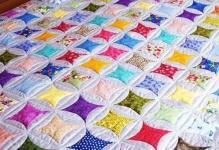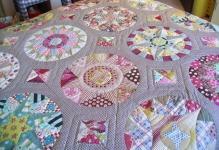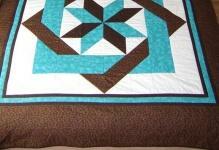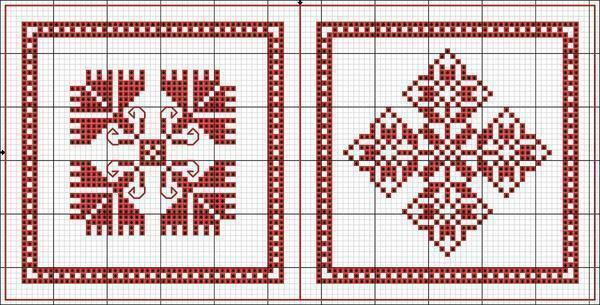 The first patchwork products found in Egypt In many cultures, needlework of patchwork sewing can be traced. The first products in the patchwork technique were found in Egypt, and they date back to -3 thousand years BC.A Frenchwoman, not having much money, but having a desire to wear dresses from expensive materials, sewed on regular fabric brocade slices, which, in fact, is also a quilted skill. Quilting does not lose its popularity even today. There are various directions and teachings that have developed historically.
The first patchwork products found in Egypt In many cultures, needlework of patchwork sewing can be traced. The first products in the patchwork technique were found in Egypt, and they date back to -3 thousand years BC.A Frenchwoman, not having much money, but having a desire to wear dresses from expensive materials, sewed on regular fabric brocade slices, which, in fact, is also a quilted skill. Quilting does not lose its popularity even today. There are various directions and teachings that have developed historically.
-
- Quilting and patchwork: craft and art in one version
- What is quilting in sewing: the skill of stitching
- Basic quilting: master class for beginners
- Sewing machines for patchwork and quilting: a review of the characteristics
- Quilting foot: features of use
- Quilting( step-by-step master class)
- Quilling ideas for inspiration( photo)
Quilting and patchwork: craft and art in one version
Quilting and patchwork techniques are often equated to each other. They are interrelated, but they have different historical prerequisites for occurrence. Quilt, which means "stitch", interconnected layers of fabric when sewing clothes, dressing gowns and blankets. And at the heart of the patchwork lies patchwork patching and stuffing things. Therefore today patchwork is understood as the technology of execution of patchwork sewing. Quilting is a broader creative direction. This is the manufacture of multi-level products.
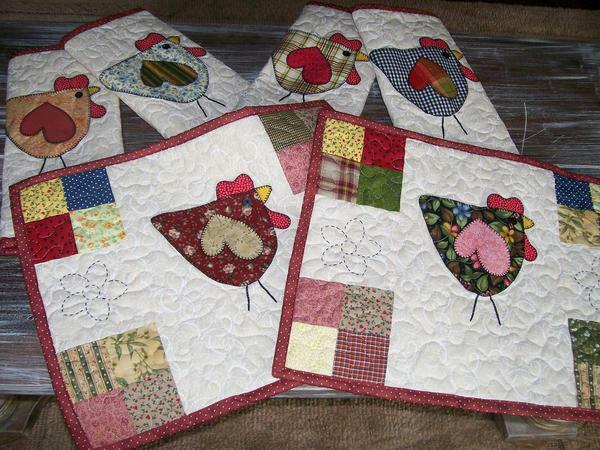 As a rule, things made in the quilting technique have 3 layers of fabric
As a rule, things made in the quilting technique have 3 layers of fabric
Most often things in the quilting technique have three layers of fabric:
- The first layer is the lining or the back layer;
- Sealed interlayer, which gives the product volume;
- Decorative layer, made in patchwork technique, applique or embroidery.
Layers between themselves are necessarily quilted. Qualitatively executed stitch shows the skill level of the performer, and the game of fabrics, the game of drawing - reveal the art talent of the master.
There are three types of quilting according to the design:
- Manual quilting;
- Engine quilting;
- Combined.
Quilting originated in many countries and absorbed national features and characteristics of peoples.
In this connection, the two most colorful quilting directions are singled out:
- Japanese. A combination of sashiko, appliqués, patchwork.
- Celtic. Celtic designs and ornaments.
Quilting is a combination of labor-intensive craft and art, which requires accuracy, accuracy and inspiration.
What is quilting in sewing: the skill of stitching
With the help of quilting techniques you can realize the most intricate ideas: sew unique clothes, table cloth, bedspread, three-dimensional paintings, bags and other decorations for the house. The beauty and quality of the product depends, first of all, on the fabric.
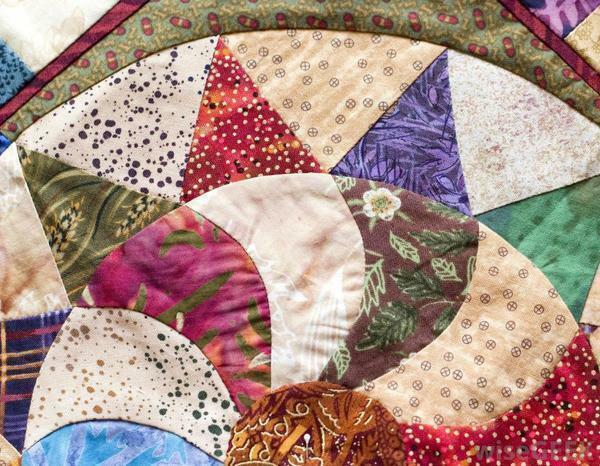 The quilting base is a stitch. It determines the level of the master
The quilting base is a stitch. It determines the level of the master
Rules for selecting textiles and color combinations in the quilting technique:
- The back layer is made either from a specialized lining fabric or from any dense fabric that is easy to wash and iron( most often it is cotton fabric).
- The color of the lining can be monochrome and patterned. It can correspond with any color from the decorative layer or contrast stand out.
- For the middle layer, sintepon is most often used. It is convenient in sewing, it is easily quilted, does not weight products.
- The decorative layer of the product, which does not wear off every week, can be made even from silk, brocade, lace and chiffon fabric pieces.
- It is desirable that the quilt is made of a material of the same density.
- The color scheme must be selected compositionally.
- It is desirable to dilute the details with a pattern with plain fabrics.
You can use programs on the Internet that help you choose the right color combination.
The basis of quilting is a stitch, it can be used to evaluate the quality of work and the skill level of the needlewoman.
The basic types of stitches in the quilting for beginners:
- Straight seam;
- Wavy seam;
- Zigzag;
- Sinuous( free-running seam).
Beginners can draw a stitch on paper. Next, sheets of paper must be attached with pins to the product, and sewing machine to draw a line on the pattern.
It is worth considering what fabrics and colors will be used for composition, what patterns will be produced. Such a product can support the interior of the house or create its own color. The main thing when choosing a fabric and choosing colors is not to be afraid of experiments and creative ideas.
Base Quilting: Master Class for Beginners
Quilting is the most time-consuming creative direction. Beginners do not need to have the talent or special skills to create products in the quilting style. For this you need to know the technology of work, process and consistency.
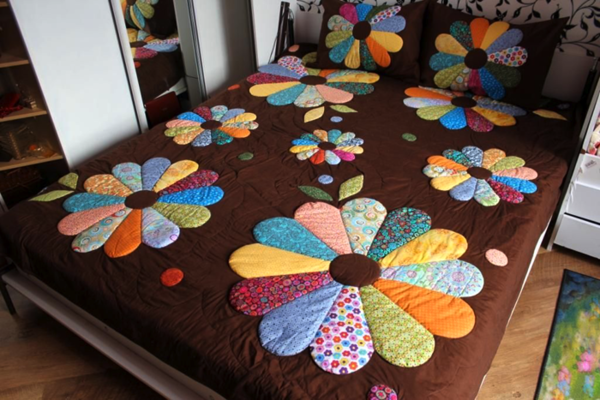 Basic sewing tools in the technique of quilting needle and thread
Basic sewing tools in the technique of quilting needle and thread
Required and useful tools for working in quilting technology:
- Roller knife or any other cutting tools that will not chewthe cloth;
- Self-renewing mat for cut fabric with linear markings;
- Transparent wide ruler;
- Ripper, needle, pins;
- Threads in tone, contrasting threads for stitches;
- Fabric;
- Sewing machine;
- Iron.
Tools can only help and speed up the work. The main job is done with a needle and thread. Therefore, do not stop, if you did not find any convenient adaptations - you can always find an alternative.
Quilting technology:
- Carry out preliminary water-heat treatment of the fabric so that it shrinks before cutting.
- Mark the fabric with allowance for allowances.
- Cut out details by marking. Alternatively, pre-prepared templates can be used.
- Lay out the patterns, form the composition, fix the details with pins.
- Piece parts or blocks to sew rows.
- Iron out every new seam "Revolving"
- Sew together the entire decorative layer of the product
- Cut the lining and sintepon( batting) cm to 5-7 more than the front.
- Sew all three layers together at the edges, and finish with a decorative stitch throughout the product.
- Edit edges with edge.
The technique of quilting is available to any beginner who has become interested in creating his own author's product. Before starting to work it will be useful to look at any master class, video or other information material on the chosen technique, to select schemes.
Sewing machines for patchwork and quilting: characteristics overview
There are tools that greatly facilitate the laborious and laborious work of the master in the technique of patchwork sewing. Sewing machines already in themselves speed up the whole process. But if quilting is a serious hobby, it is worth considering the advantages that certain models of cars are endowed with.
 If you are fond of quilting professionally, then it's worth considering purchasing a sewing machine
If you are fond of quilting professionally, then it's worth considering purchasing a sewing machine
Advanced features of sewing machines for quilting:
- Increased platform( distance from sidebar to needle).What makes it more comfortable is quilting large things. This feature is presented, for example, in models 6600 and 6500P machines Janome Memory Craft.
- Auxiliary table that increases the surface of the sewing machine. Built-in additional table is available in some models Janome( 6600, 6500P), Jaguar, Brother Innov-is.
- Automatic stitch length control with free machine stitch. Presented in Bernina machines. The special foot of the BSR keeps the same stitch length and signals if the material starts moving faster.
- Speed control sewing. When embroidering or stitching bedspreads, it is convenient to set the speed yourself, which will not depend on the strength of the pedal.
- Needle threader. The automatic threader is useful if you have to change threads often, for example, when you are quilting.
- The presence of an upper conveyor. The upper conveyor helps to smoothly move all layers of the product, as a result of which folds and creases are not collected. This detail is in the model 6600 Janome.
In the sewing machine market, no one ten-year-old is led by Japanese firm Janome, which has won the love and fidelity of many craftsmen. In connection with the growing popularity of quilting, sewing machines are modernized and equipped with new details. For example, in the 6500 Memory Craft model, there are 69 patchwork and quilting stitches. A large selection of quilting stitches is presented in the "Quilter Companion" models.
Quilting foot: features of use
The stitch quality depends on the presser foot. In addition to the standard foot in the kit of some models there are special quilting feet. With the help of such a foot, you can make a seam with an allowance of 6 mm and sew "into a split".In addition to the usual, there are also transparent paws that make it easier to follow the seam.
Seam "in the split" - one of the types of flanged joints, which is often used in quilting, performed on the front side has a clear line andThe volume form.
Sewing feet that help in quilting:
- Transparent applicator foot that allows you to better follow the stitch. Used for any work in kwing, whether it be embroidery, applique or patchwork.
- Open foot. With a free machine stitch, this foot makes it easy to move the product by hand.
- Foot with guide, thanks to which it is possible to sew smooth parallel seams without preliminary marking.
Modern sewing machines are equipped with embroidery functions of ornaments, smooth, cross-stitch, have programs on a multitude of lines, they are laid alphabet in several languages. And all sorts of decorative lines make it much easier to work with crazy patchwork and quilting.
Quilting( step-by-step master class)
Quilting is a whole art-art, where you need to learn how to freely operate with blocks, color spots and compositions. Try to bring into the product a more lively content meaning.
